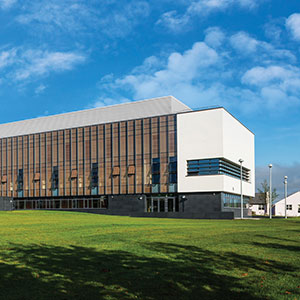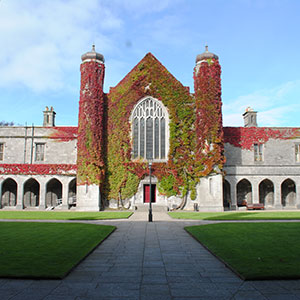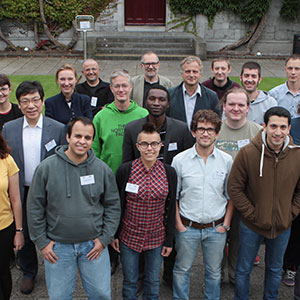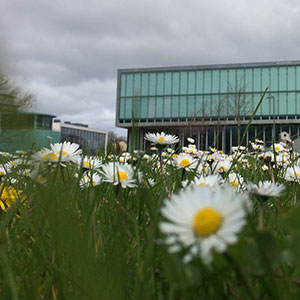-
Cúrsaí

Cúrsaí
Tá roghnú cúrsa léinn ar cheann de na cinntí is tábhachtaí dá ndéanfaidh tú choíche! Féach na cúrsaí atá againn anseo agus an méid a deir mic léinn agus léachtóirí faoi na cúrsaí sin a bhfuil spéis agatsa iontu.
-
Saol na hOllscoile

Saol na hOllscoile
Chuile bhliain roghnaíonn os cionn 4,000 duine Ollscoil na Gaillimhe mar chéad rogha. Faigh amach faoin saol in Ollscoil na Gaillimhe anseo.
-
Eolas Fúinn

Eolas faoi Ollscoil na Gaillimhe
Bí ar an eolas faoin Ollscoil seo agus na fáthanna a bhfuil sí chomh speisialta sin – an stair thar a bheith spéisiúil a bhaineann leis an Ollscoil agus an nuacht is déanaí agus na hócáidí atá ar na bacáin.
-
Coláistí & Scoileanna
- Scoil na Tíreolaíochta, na Seandálaíochta agus Léann Éireannaigh
- Coláiste an Ghnó, an Bheartais Phoiblí & an Dlí
- Coláiste an Leighis, an Altranais & na nEolaíochtaí Sláinte
- Coláiste na hEolaíochta agus na hInnealtóireachta
- Scoil na dTeangacha, na Litríochtaí agus na gCultúr
- Roinn na Gaeilge
- An tAcadamh
- Stair
- Idirnáisiúnta

Coláistí & Scoileanna
Tá aitheantas idirnáisiúnta bainte amach ag Ollscoil na Gaillimhe mar ollscoil atá á treorú ag an taighde agus rún daingean aici teagasc den chéad scoth a chur ar fáil i réimsí éagsúla saineolais.
-
Taighde

Nithe Fónta á gCruthú as Smaointe Úra
Tugann ár dtaighdeoirí aghaidh ar chuid de na dúshláin is práinní san 21ú Céad.
-
Gnó & Tionscal

Tacaíocht do Thaighde Úrnua in Ollscoil na Gaillimhe
Déanaimid deiseanna tráchtála a chuardach agus a chothú don phobal taighde in Ollscoil na Gaillimhe, mar aon le comhpháirtíocht tionsclaíochta a chothú.
-
Alumni, Cairde & Lucht Tacaíochta

Alumni, Cairde & Lucht Tacaíochta
Tá os cionn 90,000 céimí de chuid Ollscoil na Gaillimhe ann ar fud an domhain. Déan nasc linn agus beidh teacht agat ar an gcomhphobal sin ar líne.
-
Rannpháirtíocht Pobail

Rannpháirtíocht sa Phobal
In Ollscoil na Gaillimhe, creidimid go n-éireoidh níos fearr leat más féidir leat an méid a fhoghlaimíonn tú a chur i bhfeidhm i do shaol féin. Is mar gheall air sin go bhfuil béim mhór ar shocrúcháin oibre nó ar thionscadail phobail i gcuid mhór dár gcúrsaí.
Latest University News
17 December 2025
Irish academic appointed Chief Scientist of Food and Agriculture Organization of the UN
A University of Galway academic has been appointed Chief Scientist of the Food and Agriculture Organization (FAO) of the United Nations.
Charles Spillane is Established Professor of Plant Science in the School of Biological and Chemical Sciences and Ryan Institute and leads the AgriBiosciences, Food Security and Climate Change research lab in the University.
Professor Spillane joins the Core Leadership team of the Food and Agriculture Organization - the inter-governmental specialised agency within the United Nations system which leads international efforts to defeat hunger and achieve food security for all.
It is the first time an Irish person has been appointed to such a high leadership position in the FAO since its foundation in 1945.
The mission of the FAO is focused on three goals: the eradication of hunger, food insecurity and malnutrition; the elimination of poverty and the driving forward of economic and social progress for all; and the sustainable management and utilisation of natural resources, including land, water, air, climate and genetic resources for the benefit of present and future generations.
Minister for Agriculture, Food, Fisheries and the Marine, Martin Heydon T.D., said: “The appointment of Professor Charles Spillane as Chief Scientist of the Food and Agriculture Organization of the United Nations is a significant achievement for Ireland, the University of Galway and for Professor Spillane personally. He brings deep expertise in agricultural bioscience, climate-resilient food systems and sustainability, built through decades of leading interdisciplinary research at the University of Galway. His appointment will further strengthen the FAO’s capacity to advance evidence-based innovation and partnerships for resilient, inclusive and sustainable agrifood systems worldwide.”
Professor David Burn, President of University of Galway, said: “We are delighted that Professor Spillane has been appointed to this position of exceptional public service with the United Nations Food and Agriculture Organization. Professor Spillane’s appointment to this globally leading role is a testament to University of Galway’s rapidly growing reputation in agricultural research and education for food security and international development, that has been achieved over the past decade.”
Professor Charles Spillane, University of Galway, said: “I am deeply honoured to be appointed as Chief Scientist within the Food and Agriculture Organization of the United Nations. I am taking on this role with profound respect for the Organization’s remarkable history and enduring mandate to achieve food security for all, and to ensure that people everywhere have regular access to sufficient, nutritious food. The Food and Agriculture Organization is a key enabler of the world’s shared commitment to a simple but powerful idea, namely that that no person should go hungry, and that the pursuit of food security is inseparable from the pursuit of peace, prosperity, and dignity.”
The Food and Agriculture Organization is the United Nation’s lead agency for SDG2 (Sustainable Development Goal 2) - Zero Hunger and is the custodian agency responsible for 21 of the United Nation’s Sustainable Development Goal indicators.
It was founded in 1945 in response to the multiple global food crises that followed World War II. It is governed by its 195 members, namely 194 Member States and the European Union, operating on a consensus-based one country, one vote system. Ireland is one of the Member States, where the Department of Agriculture, Food and the Marine leads the state’s engagement.
The FAO has an annual budget of over US$2billion, with more than 16,000 staff working across the headquarters in Rome, five regional offices and 130 country offices.
Read more information about the Food and Agriculture Organization of the United Nations here: www.fao.org.Ends
16 December 2025
Student awarded inaugural A.Menarini scholarship for diabetes research
University of Galway, in partnership with the HRB Diabetes Collaborative Clinical Trial Network, has announced the inaugural A.Menarini Pharmaceuticals Ireland Scholarship.
The successful student is Ruth Alejandra Huerta Sinesio, originally from Mexico City, who was awarded the scholarship for her outstanding achievements and commitment to advancing diabetes research and patient care.
The A.Menarini Pharmaceuticals Ireland Scholarship, supported by Galway University Foundation, provides full financial support for a student in the Master of Science in Clinical Research.
Ruth Alejandra Huerta Sinesio was selected from a highly competitive field of candidates, demonstrating a strong dedication to improving health outcomes through her work and experience. The award will enable her to pursue advanced training and to contribute to pioneering research activities, as well as strengthening her role within the Diabetes Collaborative Clinical Trial Network and broader diabetes community.
Professor Fidelma Dunne, Director of the HRB Diabetes Collaborative Clinical Trial Network and the Institute for Clinical Trials at University of Galway, said: “We are immensely proud of Ruth Alejandra and all she has accomplished to date in her career. Her passion, drive, and commitment embody exactly what this scholarship stands for. We are deeply grateful to A.Menarini for their generous support, which enables us to nurture the next generation of clinical researchers who will make a transformative difference in Ireland and far beyond. Their investment in education and research ultimately supports the lives of people living with diabetes.”
Ruth Alejandra Huerta Sinesio said: “This scholarship motivates me to keep striving for excellence. I’m grateful to A. Menarini for this award, which supports my professional growth and my mission to address a major public health challenge. It’s an honour to be supported by a community that believes in students’ ability to improve care for people with diabetes. I hope to turn my experience and motivation into lasting impact, honouring my loved ones and improving lives worldwide.”
As part of A.Menarini Pharmaceuticals Ireland support for students at University of Galway, the company will provide three further annual scholarships in the coming years to support students demonstrating academic excellence, leadership, community engagement, or financial need. The company has also pledged support for education and training within the HRB Diabetes Collaborative Clinical Trial Network, including professional development, multidisciplinary training and expanded Patient and Public Involvement (PPI) initiatives. The investment will strengthen Ireland’s capacity to deliver world-class clinical research and foster a new generation of leaders dedicated to improving diabetes care across the globe.
Ends
15 December 2025
All-Ireland Peatlands Centre of Excellence launched
RePEAT research project showcases scale of digitisation of 19th century bog maps
University of Galway has announced the launch of the All-Ireland Peatlands Centre of Excellence to lead research and policy development on restoration and conservation of bogland.
The Centre has been established at the University’s Ryan Institute to help address critical challenges linked to peatlands, including decarbonisation, biodiversity loss, just transition and cultural heritage.
Along with academic research and policy development, it will also serve as a hub for innovation and training in relation to protection of peatlands on the island of Ireland and overseas.
The establishment of the All-Ireland Peatlands Centre of Excellence builds on a strong collaborative ethos among multiple universities, government agencies and community groups.
It also follows on from the RePEAT project, a research collaboration involving University of Galway and Trinity College Dublin which identified former peatlands areas that are suitable for alternative management and informs national bog rewetting projects to reduce greenhouse gas emissions.
Using Bog Commissioner maps from the 19th century which were originally designed to facilitate drainage, RePEAT researchers digitised the maps and turned them against their initial purpose in order to establish the original baseline extent of peatlands. The maps recorded the large-scale survey of more than 1 million acres of bogs between 1810 and 1814.
The RePEAT project was funded by the Department of Agriculture Food and Marine and the Environmental Protection Agency.
Dr Terry Morley, Lead of the new All-Ireland Peatlands Centre of Excellence and researcher on RePEAT project, Ryan Institute, University of Galway, said: “The All-Ireland Peatlands Centre of Excellence will bring together scientists, policymakers, landowners, and communities.
“We hope that through this new Centre of Excellence we will be able to strengthen national capacity for sustainable peatland management and ensure long-term environmental and societal benefits from restoration and conservation.
“University of Galway is uniquely situated to lead this centre, with blanket and raised bogs at our doorstep and broad interdisciplinary peatland research expertise.”
Dr John Connolly, a researcher on the project from Trinity College Dublin, said: “The RePEAT project has identified more than 200,000 hectares of former peatland, which is now in other land uses. These areas represent emissions many times higher than their baseline and can be used to identify areas that may be suitable for restoration and rewetting under Ireland’s Climate Action Plan.”
A special showcase outlining the findings of the RePEAT research project is being hosted in the Orbsen Building on the University of Galway campus from Monday December 15th-19th while a public lecture will be held on Thursday, December 18th at 5pm in the Michael D Higgins Auditorium.
Ends









